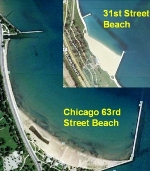
Numerical Ocean Models Help Find Causes of Dirty Beaches
In 2009-2010, the U.S. Environmental Protection Agency stepped up its focus on water quality monitoring at recreational beaches by budgeting $475 million for an interagency Great Lakes restoration initiative. The project, which includes studies by the U.S. Geological Survey (USGS) and Michigan State University, targets the most significant problems.
USGS and the university are trying to identify the transport pattern of fecal bacteria around beaches in southern Lake Michigan. EPA and the National Oceanic and Atmospheric Administration (NOAA) also are involved in the project.
Lead scientist Zhongfu Ge, Ph.D., said that predicting pathways of contaminants and indicator bacteria is feasible through the use of existing ocean current models that NOAA adapted for the Great Lakes. Lake-scale current movements in Lake Michigan, for example, have been monitored hourly using ocean models. “Similar models can be applied to smaller beach waters. All it takes is information from the lake-scale model and a finer grid zooming onto your beach,” according to Ge. This type of model has been pursued by a few research groups and supported by NOAA’s lake-scale databases.
Ge is a research scientist for the U.S. Geological Survey Lake Michigan Ecological Research Station and the Department of Civil and Environmental Engineering at Michigan State University. Ge and Walter Frick at EPA developed a first version of Virtual Beach, now an internationally known software package being beta-tested by many government and academic participants.

Two Chicago beaches with long and short pairs of breakwaters (Google maps image).
This modeling technique is highly portable because, for different coastal areas, the modeler only needs to import the beach contours and the distribution of water depth (the bathymetry) into the computer program, Ge explained. The kernel of the ocean current model need not be changed and can be built into a special module of the program. The coastline and bathymetry involved in the preprocessing of the model can be assisted by GIS tools and online regional databases. More roughly, a modeler can use nautical charts with clear marks of soundings, he said.
A recent application of ocean models to recreational beaches was for Chicago 63rd Street Beach. Based on a survey of fecal indicator bacteria, Escherichia coli, at 23 beaches along the 37-km lakefront of Chicago in the summer from 2000 to 2005, the 63rd Street Beach had the highest E. coli counts, indicating heavy microbial contamination.
The reason for the high bacteria concentration in the beach water was not clear until my team conducted a study using numerical (computer-aided) models to trace the E. coli movement, their settling to the lake bottom and their background mortality. The numerical results can show the change of the spatial distribution of E. coli with time around the beach. Ge's major conclusion is that the long breakwaters that are the northern and southern bounds of the embayed beach tend to keep contaminants in the embayment as they are designed to keep beach sands in. More specifically, “the breakwaters do break long shore currents, which makes the current circulation in the embayment extremely slow. Such a current cannot release bacteria out of the embayment. Fecal bacteria just sink and settle. Next morning when wind picks up and waves are high, they are resuspended,” Ge said. The transport of sand and bacteria in the beach water are actually the same, only except that bacteria die (or become “nonculturable”) with time and by exposure to environmental stresses. The embayment design apparently poses a threat to human health if the beach is used for recreational purposes.
There might be a window of opportunity for finding the optimal design of breakwaters for sand retention and contaminant release at the same time, Ge suggested. More studies are planned to explore this optimization. This would be a cooperative endeavor of both environmental and coastal engineers.
The article by W.E.Frick, Z. Ge, and R.G. Zepp, "Nowcasting and forecasting concentrations of biological contaminants at beaches: A feasibility and case study," was published in Environmental Science & Technology.
The U.S. Congress passed the Beaches Environmental Assessment and Coastal Health Act in 2000 and sought to prevent people from becoming ill through direct contact with polluted beach waters.